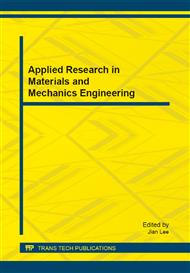[1]
Zahraee, S. M., Hashemi, A., Abdi, A. A., Shahpanah, A., Rohani, J. M. (2014). Lean Manufacturing Implementation through Value Stream Mapping: A Case Study. JurnalTeknologi(Sciences & Engineering), 68(3), 119-124.
DOI: 10.11113/jt.v68.2957
Google Scholar
[2]
Zahraee, S.M., Hatami, M., Yusof , N.M., Rohani, M., Ziaei, F. (2013).
Google Scholar
[3]
Zahraee, S. M., Hatami, M., Rohani, J. M., Mihanzadeh, H., Haghighi, M. (2014). Comparison of Different Scenarios Using Computer Simulation to Improve the Manufacturing System Productivity: Case Study. Advanced Materials Research, 845, 770-774.
DOI: 10.4028/www.scientific.net/amr.845.770
Google Scholar
[4]
Zahraee, S. M., Shariatmadari, S., Ahmadi, H., Hakimi, S., Shahpanah, A. (2014).
Google Scholar
[5]
Zahraee, S. M., Golroudbary, R. S., Hashemi, A., Afshar, J., Haghighi, M. (2014). Simulation of Manufacturing Production Line Based on Arena, Advanced Materials Research , 933, 744-748.
DOI: 10.4028/www.scientific.net/amr.933.744
Google Scholar
[6]
Mettam, J. D. (1967). 'Forecasting delays to ship in port. ', Dock Harb. auth., 47(April), 380–382.
Google Scholar
[7]
Nicolaou, S. N. (1967). 'Berth planning by evaluation of congestion and cost. ', J. Wtrwy. and Harb. Div., ASCE, 93(4), 107–132.
DOI: 10.1061/jwheau.0000522
Google Scholar
[8]
Edmond, Eric D, (1975). Operating Capacity Of Container Berths For Scheduled Services By Queue Theory. Dock and Harbour Authority 56 (661), 230-234.
Google Scholar
[9]
Kia, M. P, (1992). Minimize cost of berthing (Port of Melbourne). National Conference Publication - Institution of Engineers, Australia. 92 (8) , 231-237.
Google Scholar
[10]
Zrnić, D. N, Dragović B.M., Radmilović, Z.R. (1999). Anchorage-ship-berth link as multiple server queuing system. Journal of Waterway, Port, Coastal and Ocean Engineering 125( 5) , 232-240.
DOI: 10.1061/(asce)0733-950x(1999)125:5(232)
Google Scholar
[11]
Alexopoulos C, Seila AF. Output data analysis. In: Banks J, editor. Handbook of simulation: principles, methodologies, advances, applications, and practice. NewYork: Wiley; 1998. [Chapter 7].
Google Scholar
[12]
Legato P, Mazza RM. Berth planning and resources optimisation at a container terminal via discrete event simulation. European Journal of Operational Research 2001; 133(3): 537–47.
DOI: 10.1016/s0377-2217(00)00200-9
Google Scholar
[13]
Pietro Canonaco, Pasquale Legato, Rina M. Mazza, Roberto Musmanno. A queuing network model for the management of berth crane operations. Computers & Operations Research 35 (2008) 2432 – 2446.
DOI: 10.1016/j.cor.2006.12.001
Google Scholar
[14]
Laih, C. -H., Lin, B., Chen, K. -Y, (2007). Effects of the optimal port queuing pricing on arrival decisions for container ships. Applied Economics 39( 14) , 1855-1865.
DOI: 10.1080/00036840500447765
Google Scholar
[15]
A. Shahpanah , S. Poursafary , S. Shariatmadar , A. Gholamkhasi , S. M. Zahraee. 2014. Optimization Waiting Time at Berthing Area of Port Container Terminal with Hybrid Genetic Algorithm (GA) and Artificial Neural Network (ANN). Advanced Materials Research 902: 431-436.
DOI: 10.4028/www.scientific.net/amr.902.431
Google Scholar
[16]
A. Shahpanah, A. Hashemi, G. Nouredin, S. M. Zahraee, S. A. Helmi. 2014. Reduction of Ship Waiting Time at Port Container Terminal Through Enhancement of the Tug/Pilot Machine Operation. Jurnal Teknologi 68 (3), 63-66.
DOI: 10.11113/jt.v68.2931
Google Scholar


